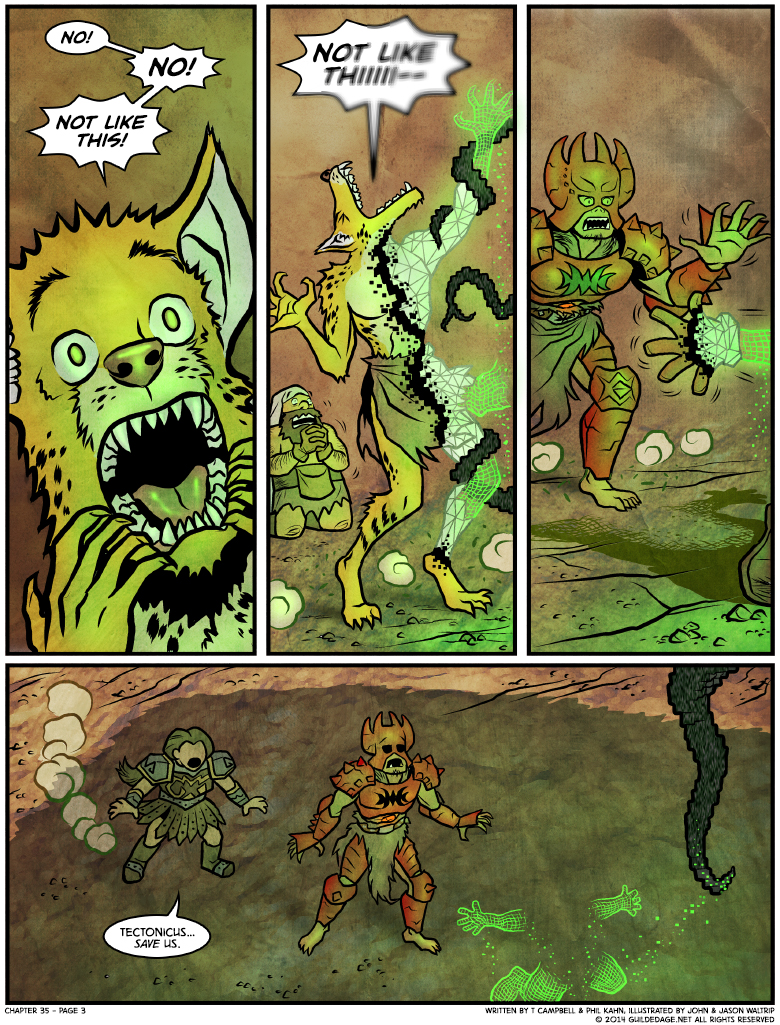Annotated 35-3
 We haven’t spent a lot of time with gnolls or dwarves who weren’t total badasses, so the fate met by these two might register a little more seriously than if it were a couple mild-mannered humans or such.
We haven’t spent a lot of time with gnolls or dwarves who weren’t total badasses, so the fate met by these two might register a little more seriously than if it were a couple mild-mannered humans or such.
Some readers felt that the way these two died was a “fourth wall break,” an acknowledgment that Arkerra really was just a bunch of data on a server farm somewhere. I can see the reasoning for sure, but that isn’t really my thought process. The Beast here comes from a world where everything behaves like a computer’s fever dream, so it and its effects will bear the fingerprints of that world. Of course, Flo and I often clashed about how much of a “game” this was, so maybe she’d say different.
Considering how Tectonicus later fared against the modified and further strengthened version, I’d say he’d have a fifty-fifty chance if he deigned to join this battle. Maybe 65-35, if he didn’t mess around.











Huh, I guess I always assumed that polygons were from the beast itself. It didn’t occur to me to associate them with the game the characters are a part of until you mentioned it.
Yeah, I always chalked it up to the monster breaking reality like the trail it left behind but I was always on the mirrored universe vs game side of the argument. We never see anything remotely like this prior.
The first time I read this comic, I simply thought that Arkerra was a meticulosly detailed and well programed game that felt real if you were a player with the right mindset (even more so if you were in those VR immersion tanks) But at the end of the day, my interpretation was that the world of Arkerra was just code that represented non-existing people and places. In this interpretation, HR’s magick allowed him to alter that code without having to use a computer, and to travel mentally to that world of code without having to use other means (i.e. an immersion tank)
I have never considered -until now- that Arkerra could also be another reality that, maybe due to an incredible coincidence, or maybe because of some transdimensional clairvoyance, inspired a computer game made in its likeness that operates like a voodoo doll (the game affects the real world it represents)
The “It’s just a game” interpretation is less complicated and less messy, but the “Arknerra is both a game and it’s real, too” is plenty interesting, I gotta say
I think it’s been signalled quite heavily that at very least Arkerra is like “the sculpture was always in that block of marble, the sculptor just removed all the other bits”, or even more, that Arkerra was a magico-technologically created world, in a way that made it real, world history and all.
Sort of like the Simulation Hypothesis, but with magic servers.
But you see, that’s just it. Both theories contradict each other. The sculpture was a preordained shape already existent, just waiting for the artist to bring it forth, whereas the magic/tech world was unambiguosly created (non-existent before its creation).
Until this day, I thought it was the latter case.
Might be time for the both of you to reread chapter 44. Especially page 27, though it might be better to get some context before skipping straight to it.
I honestly forgot about that. Good catch, sir/ma’am.
The way I understand it, HR did create Arkerra, using computer code plus Magic, and then this creation (which is more than a simulation) started going its own way — which is why HR finds that he cannot, after all, control what’s happening, and why the Five are alive and well in Arkerra even if they’re (mostly?) dead in Sepia World.
Arkerra is not just more realistic than any other game, it’s also more *real*, even more than HR thought it was going to be.
Does it count as spoilers to link to a later chapter from the non-annotated stuff?
I don’t understand why anyone would consider the deaths breaking the first wall when wireframe polygon meshes have been a heavy part of the cosmetics/design of WAV and the monster for what, the last 20 pages?